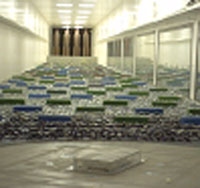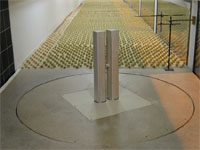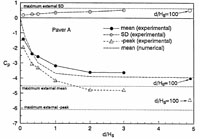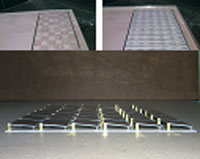Fluid Mechanics and Fluid Dynamics
Research
Representative current research projects involving the WEFM faculty, staff and students include:

Refined Physical Modeling of Wind Effects on Low Buildings:
This long-term effort, supported by National Science Foundation and other sponsors, is focused on evaluation of existing and development of new techniques for wind-tunnel modeling of wind effects on buildings and structures. Laboratory results are validated by comparison with field results. The experimental data obtained at WEFL and at collaborating wind engineering laboratories word wide is being incorporated in a distributed (XML-aided) data base, to be utilized in a database-assisted wind resistant design of buildings.

Investigation of Aerodynamic Interference and Structural Coupling Effects on Wind-induced Response of Tall Buildings:
Various configurations of structurally connected tall buildings are being considered. The experimental technique based on the use of two synchronized high-frequency response force balances has been developed and is being utilized in these investigations. The effects of close proximity of the buildings on the wind induced loading and the building response are evaluated. The coupled modal loading is employed in calculation of the structural response of the buildings and the effects of the structural coupling on the responses are evaluated using advanced analytical and modeling tools.


Mitigation of Adverse Wind Effects on Loose-laid and PV Roofing Systems:
Wind tunnel studies and analytical/numerical modeling are utilized to investigate and mitigate adverse effects of wind on performance of various innovative roofing systems, including photovoltatic (PV) modules/arrays. Fundamental studies of generic configurations are carried out to gain insight into fluid mechanics phenomena governing aerodynamic performance/wind resistance of “real-life” systems.
Computational Wind Engineering Simulations and Experimental Validation of Wind Effects:
Commercial and in-house developed software is utilized in numerical simulations of various wind effects. Laboratory (wind tunnel) data obtained at WEFL are employed to validate the numerical results. Datasets resulting from simulations are processed using advanced tools. The investigated phenomena include: flow past bluff bodies and complex terrain, wind loading on buildings, other structures and components, pedestrian-level wind environment, others.

The scope of Wind Engineering research carried out by graduate students affiliated with WEFM/WEFL is well represented by the following sample of titles of their dissertations and theses:
Turbulence Effects on Wind-Induced Building Pressure (Ph.D.), Analysis of Building Wind Pressure Using Proper Orthogonal Decomposition, Autoregressive Moving Average and Neural Networks (Ph.D.), Wind Loading on Loose-Laid Roofing Paver Systems (Ph.D.), Large Eddy Simulation of Flow Past a Square Cylinder Using Finite Element Method (Ph.D.), Numerical Prediction of Turbulent Flow and Aerodynamic Loading on Bluff Bodies (Ph.D.), Wind-Tunnel Modeling of Low-Rise Structures (Ph.D.), Digital Synthesis of Wind Pressure Fluctuations on Building Surfaces (Ph.D.), Physical Modeling of Tornado Vortices (M.S.), Physical Modeling of Wind-Forced Natural Ventilation (M.S.), Haar Transform Analysis of Approach Flow and Dislodging of Roofing Pavers (M.S.), Wind Tunnel Study of Full Aeroelastic Roof Model (M.S.), Fluctuations of Area-Averaged Wind Pressures on Low-Rise Buildings (M.S.), Design and Testing of Multi Degree of Freedom Model of a Tall Building (M.S.), and others.